“Dangerous objects are glamorous places to be.” – Jack Goldstein.
Explosions, lightning, fire and bombs are some of multi-media artist Jack Goldstein’s preferred, glamorous places. A retrospective at the Jewish Museum in New York City frames Goldstein as a central figure of the Pictures Generation of the 1970s and 1980s, although he saw himself as more of an art director or producer. Through his paintings, films, installations, writings, and pioneering sound recordings, viewers can follow the thread of his creations.
"Jack Goldstein x 10,000" is the first American retrospective of Canadian-born artist Jack Goldstein (1945-2003). It was first presented in 2012 at the Orange County Museum of Art in Newport Beach, CA. The retrospective was curated there by guest curator Philipp Kaiser. The retrospective at The Jewish Museum was curated by Joanna Montoya, Neubauer Family Foundation Assistant Curator.
The retrospective's title "Jack Goldstein x 10,000" comes from a 1985 interview with Chris Dercon, director of the Tate Modern in London. The artist downplayed his common name and said “It’s just a name of a name, you can find 10,000 Jack Goldstein’s in the telephone book.”
The exhibit runs through his career chronologically, it begins - and ends - as he did, with short films that focus attention on images that range from simple narrative – a pixilated man jumping (The Jump, 1978), a nail being pounded (A Nail, 1971), feathers falling softly onto a chair (The Chair, 1975).
The Jump is also screening through August at Times Square from 11:57 p.m. to midnight. The video is being projected onto 15 large digital signs.
.
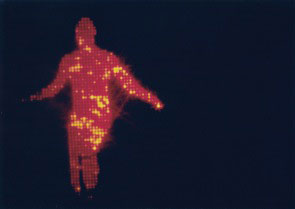
"The Jump, 1978." by Jack Goldstein. Film screenshot.
.
From the films, Goldstein merged into performance art and sculpture. One of his earliest pieces that was destroyed has been recreated here – rectangular blocks of wood stacked up ten feet high but not attached in any way but gravity. It’s dependent on the elements and forces around it, a metaphor for the fragility and uncertainty of life, a theme he returned to again and again.
Goldstein made sound recordings both as art and audio, one can stand under a giant overhead speaker and listen to the colorful row of 45s and LPs lined up in the glass cases. Most of the sounds are those of struggle – The Lost Ocean Liner, The Burning Forest, The Tornado, all made in 1976. He paired the colors of the vinyl and the labels with the moods suggested by the noise.
.
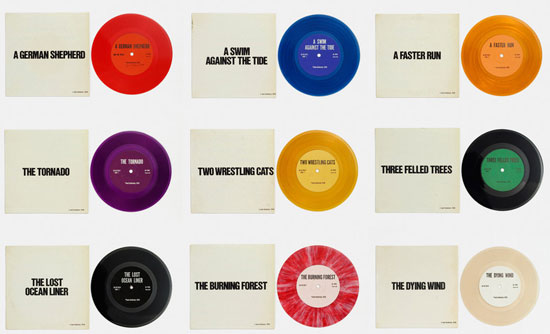
"Sound recordings vinyl records installation" by Jack Goldstein, 1976.
.
As interesting as all this varied, experimental work was to the artist, galleries and collectors had a harder time connecting with it. So in an only-in-early-1980s-New-York story, Goldstein moved into an inexpensive, enormous loft in Williamsburg, Brooklyn and began to paint.
The sheer size of the studio and double height of the walls allowed him to come out of the gate with huge paintings, some as large as ten feet long by six to eight feet high. Ever the director, he chose images as grand as the scale – bombs destroying cities, lightning strikes, volcanoes blowing their top. And he didn’t “paint” them, he gave actual photos – a theme he was strict about – to his assistants and had them make the art using spray guns and auto-pinstriping techniques to get a smooth matte surface, a technique he pioneered.
.
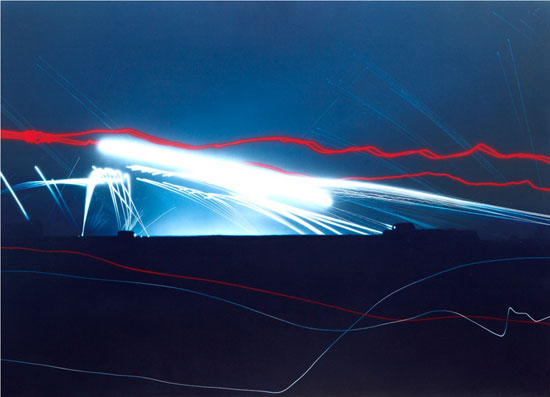
"Untitled 1983" by Jack Goldstein.
.
These clean, massive wow factor paintings became Goldstein’s signature work and gave him the recognition he craved. About a dozen of them are in the retrospective.
"He said he wanted the image just ‘plain laid on,' only white acrylic paint applied on top of set black," says artist Ashley Bickerton, Goldstein's primary assistant for four years. "That, he said, was the point of his work, direct, impersonal, like a single color silkscreen, just the found image represented coldly, but at the scale of monument."
.
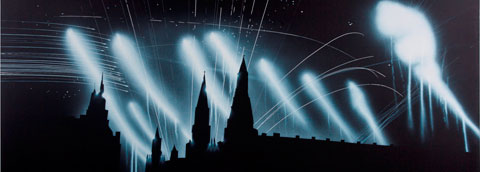
"Untitled, 1982" by Jack Goldstein. Acrylic on canvas, 84 x 144 inches.
.
"I think these are about a kind of existential nihilism, whether it's through natural phenomena or man-made phenomena," said Adam Lindemann, a sponsor of the exhibit. "These are all things that are bigger than man."
.
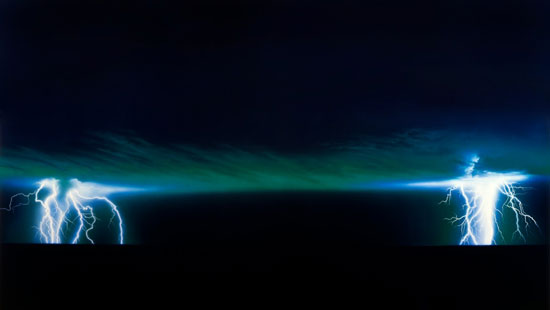
"Untitled, 1983" by Jack Goldstein. Acrylic on canvas, 84 x 144 inches.
.
By the 1990s Goldstein’s addictions, depressions, and self-destructiveness drove him virtually underground, he left New York and lived in a self-imposed obscurity in east Los Angeles. His final works were cut up word collages from philosophy books.
He made one last film, Under Water Sea Fantasy, that ends the exhibit – a dreamy, hyper color drenched pastiche of schools of fish, volcanoes and eclipses.
.
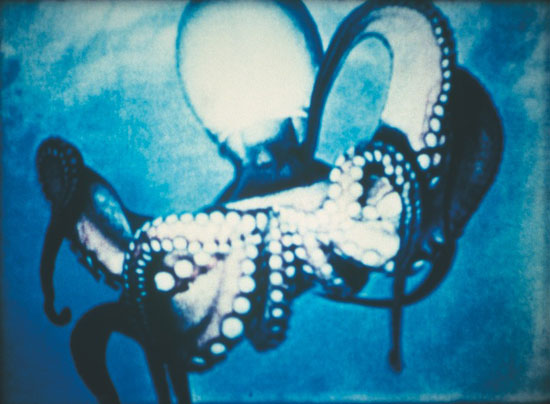
"Underwater Sea Fantasy" by Jack Goldstein, 2002. Film Screenshot.
.
Goldstein killed himself in 2003, using the forces of gravity, becoming his own moment of nihilistic spectacle.
.
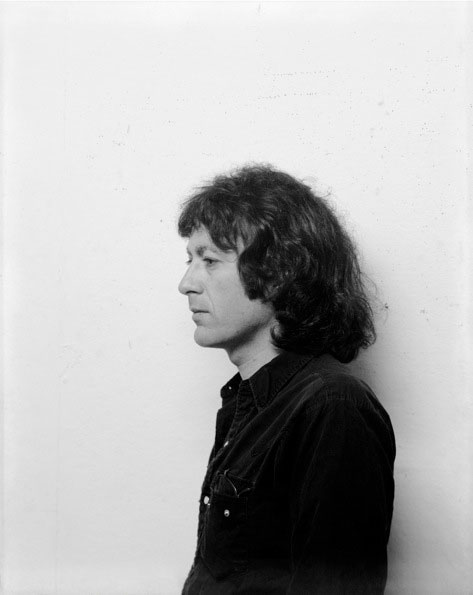
James Welling photo of Jack Goldstein, 1978.
.
BASIC FACTS: "Jack Goldstein x 10,000" is on view through Sept. 29, 2013 at The Jewish Museum. It was organized by Joanna Montoya, Neubauer Family Foundation Assistant Curator for The Jewish Museum. The exhibition is accompanied by a full color catalogue. The Jewish Museum is located at 1109 Fifth Avenue, New York, NY 10128 www.thejewishmuseum.org
.

Photograph by Ka-Man Tse for @TSqArts.
.
Goldstein’s 1978 video The Jump will be screened in Times Square in New York City every night in August from 11:57 p.m. to midnight for the Midnight Moment. The video will be projected onto on 15 large digital signs. In The Jump, Goldstein used the innovative animation technique of rotoscoping to show a leaping diver, his form a blur of red and sparkling gold, performing a somersault and disintegrating into fragments.
Midnight Moment is a presentation of the Times Square Advertising Coalition (TSAC) and Times Square Arts. Goldstein's projection is presented in partnership with The Jewish Museum.
On Sept. 22, The Jewish Museum will present "Symposium: Who is Jack Goldstein" beginning at 12:30 p.m. The symposium will discuss the legendary Pictures exhibition curated by Douglas Crimp in 1977; the influential post-studio classes of John Baldessari at the California Institute of the Arts in Los Angeles where Goldstein received his MFA; and explore the impact of the Pictures Generation on artists today.
For details and for tickets, click here.
Arts writer Sandra Hale Schulman had a 2-year relationship with Jack Goldstein. For an excerpt of a work in progress, “You Don’t Know Jack”, visit www.sandraschulman.com.
________________________________________
© 2013 Hamptons Art Hub LLC. All rights reserved.
